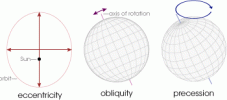
A Roman altar with the Sun in its chariot on the left, and Vulcan, the god of fire and volcanoes on the right. The climate gods long favoured the Roman Empire, with Earth’s orbital dance credited for increasing the amount of solar energy falling on Earth at the time. Image copyright: Nick Thompson, used via Flickr Creative Commons License.
Our climate has changed before. It’s something most of us realise and can agree on and, according to Skeptical Science, it’s currently the most used argument against human-caused warming. If such changes have happened naturally before, the argument goes, then surely today’s warming must also be natural. It’s an appealing idea, with an instinctively ‘right’ feel. Nature is so huge compared to us puny humans, how can we alter its course? The warming we’re measuring today must just be a natural fluctuation.
It’s such an appealing argument that at the beginning of the 20th century that’s just what many scientists thought – that humans couldn’t alter Earth’s climate. In the time since, our knowledge has come a long way. We’ve explored space, become able to build the electronics that are letting you read this, and climate science has likewise advanced and benefited from these advances.
So what do we know today that might convince the sceptical scientists of 115 years ago that we’re warming the planet? Recently, Richard Mallett, one of my Twitter friends who describes himself as sceptical about mainstream climate science, made a point that serves as an excellent test of our current knowledge:
@andyextance Climate science should be able to explain the Holocene, Roman, Medieval and current warmings and the cold periods in between.
— Richard Mallett (@richard_mallett) May 11, 2014
Of the historical warmings he’s referring to, perhaps the least familiar is the Holocene, which is ironic, as the Holocene is now. It’s the current period of geological time that started at the end of the last ice age, 11,700 years ago. By 1900 scientists would have known the term, but they couldn’t explain why it wasn’t as icey as before.

Three variables of the Earth’s orbit—eccentricity, obliquity, and precession—affect global climate. Changes in eccentricity (the amount the orbit diverges from a perfect circle) vary the distance of Earth from the Sun. Changes in obliquity (tilt of Earth’s axis) vary the strength of the seasons. Precession (wobble in Earth’s axis) varies the timing of the seasons. For more complete descriptions, read Milutin Milankovitch: Orbital Variations. Image credit: NASA/Robert Simmon.
The explanation we have today comes thanks to the calculations Milutin Milanković worked out by hand between 1909 and 1941. Milutin showed that thanks to the gravitational pull of the Moon, Jupiter and Saturn, Earth’s orbit around the Sun varies in three ways. Over a cycle of roughly 96,000 years our path varies between more circular and more oval shapes. The other two ways come because Earth’s poles are slightly tilted relative to the Sun’s axis, which is why we have seasons. The angle of that tilt shifts over a roughly 41,000 year cycle. Earth also revolves around that tilted axis, like a spinning top does when it slows down, every 23,000 years.
Together these three cycles change how much of the Sun’s energy falls on and warms the Earth, in regular repeating patterns. Though that idea would be the subject of much controversy, by the 1960s data measured from cylinders of ancient ice and mud would resolve any doubt. The slow descent into ice ages and more abrupt warmings out of them – like the one that ushered in the Holocene – come from Earth’s shimmies in space. Read the rest of this entry »




